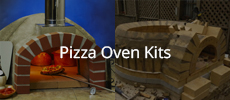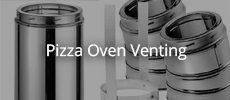Utah is of course correct, and I also would recommend tapering your inner arch. However, from the perspective of how much depth your inner arch occupies, I think you can roughly approximate that as a half brick even with a tapered arch, and that's standard and easy enough.
I would not recommend trying to build your outer arch just a half brick/4.5" deep--you're going to have a real hard time making that stable and get a big enough opening for the flue. 6" you might get away with. Possibly you could also think about casting your gallery, rather than building from brick? David S on this forum is a proponent for doing that even on otherwise brick ovens. That would let you do whatever shape and dimensions please you..
Also second checking that you have enough room to operate the oven; if not you could rotate 90 degrees and use the other corner, which appears to face out into the yard.
X
-
If you use a tapered inner arch, (recommended) then you cannot use 1/2 bricks, they require using a full brick that is cut down to a taper. This is one of the most difficult concept for builders to visualize bit it is worth the effort since the dome meshes with the inner arch consistently and with less complex cutting. There are dozens of examples on the blog of "tapered" inner arches.
Leave a comment:
-
Looking at the second picture in the above post (#16), you want to make sure that there is enough space behind you to pull out a long pizza peel without hitting anything behind your back. I would recommend testing this with a broomstick or something similar. Most likely, you'll want to build a pretty wide outer arch (as much as space allows) to allow you enough left-to-right movement of the peel to pull it out at an angle.
Leave a comment:
-
rsandler wrote: "You might think about shortening your flue gallery so that the door intersects further out on the arc of the floor. It looks like you've laid out a one-brick length gallery, 9" deep, which usually works well to fit a 6" diameter flue, which is needed for a 36" oven. But, if you've got a smaller dome, you might get away with a smaller flue, and could shorten the gallery as a result."
I've played around with gallery length, using half bricks (4-1/2") for both inner and outer arches. Still, the gallery to the outer arc is going to have to go right up to the front edge of the hearth. It's going to be tight, but I can't really move the dome farther back else I lose the necessary buffer for insulation blanket and render. It shortens the flue gallery by about 1" (as measure from outside of inner arch) This configuration means a 3" throat leading to a planned 5" dia chimney. Floor bricks as shown need to be beveled for a better (less mortar) fit for better heat retention. Need to come up with a jig to be able to cut odd angles as saw only has a 45 degree jig. Not sure what I have to craft a jig but have found a Rigid mitre gauge for a tile saw that will clamp to the back fence of saw. Its just rather expensive. My saw will only allow me to cut my bricks when laying on flat wide side so beveling may be limited. I did read on forum that "mortar is your friend" or "mortar covers a multitude of sins" -something to that affect. For short cuts I've just held bricks in place to get them started and keep the fingers well away. Not ideal, though.
Welcome any comments on the floor/flue gallery intersection and if the half bricks will work for arches. Building the outer arch right up to the front edge of the hearth I think is going to be the hard part. Maybe not..4 Photos
Leave a comment:
-
For the 27" oven, a 16" opening should work fine; 18" might be a bit wide but should be okay if you prefer. For the arch lip, 3/4" is a bit tight; aim for at least 1" to accommodate a door better. A 5" chimney sounds reasonable for your setup.
Leave a comment:
-
As an exploration for my build I created a little spreadsheet to compare insulation thicknesses. It's quick and dirty and all in metric and just explores some of the variables I was looking at. Once my build is finished I'll check it properly, add 'non-sensical'Originally posted by JDub36" View PostThanks for the advice on the Sairset guys. It is officially nixed. My local brickyard said they have fireclay, the price quoted just seemed excessive. But what isn't these days..? The cost per pizza just went up, but who's counting? And thank you, Giovanni, for the links and advise on broken tiles. I'll check those out-
Well, it is summer, and the boat is out of the shop so going to the lake this weekend. Maybe in the meantime, someone will talk some sense in to me regarding my questin about 2" FB floor insulation vs. 4" and is 4" would be compulsory if, say, I wanted to bake a loaf of bread the day after firring up the oven for pizza.. I know the question isn't quite a yes or no, but just looking for some opinions if any one has any. Thanks again! units and turn it into a google sheet that everyone can use. It considers the insulation thickness to be similar around the whole build (ie. CalSil thickness = blanket thickness as well), takes my iD of 800mm as the main diameter and neglects any heat loss through the door. It does however give a good impression of the physics at play, and the relative loss of insulation function above a certain thickness:
units and turn it into a google sheet that everyone can use. It considers the insulation thickness to be similar around the whole build (ie. CalSil thickness = blanket thickness as well), takes my iD of 800mm as the main diameter and neglects any heat loss through the door. It does however give a good impression of the physics at play, and the relative loss of insulation function above a certain thickness:
Compare the red (1/2" insulation), blue (2" insulation) and purple lines (4" insulation): the difference between red and blue is huge, but between blue and purple you're basically not gaining a lot: after 12 hours there's maybe a +15C difference in oven temperature between 2" and 4", vs -40C for the 1/2" variant.
The brown and green lines explore variation of some other parameters: brown: using full bricks instead of half bricks on the dome, while keeping internal diameter and insulation thickness the same (adds a huge amount of thermal mass but also significantly increases the heat loss area and the thermal gradient inside of the bricks). Green: using an iD of 1000mm instead of 80mm and keeping the other parameters the same (adds thermal mass, but also significantly increases the heat loss area).
1 Photo
Leave a comment:
-
Thanks for the advice on the Sairset guys. It is officially nixed. My local brickyard said they have fireclay, the price quoted just seemed excessive. But what isn't these days..? The cost per pizza just went up, but who's counting? And thank you, Giovanni, for the links and advise on broken tiles. I'll check those out-
Well, it is summer, and the boat is out of the shop so going to the lake this weekend. Maybe in the meantime, someone will talk some sense in to me regarding my questin about 2" FB floor insulation vs. 4" and is 4" would be compulsory if, say, I wanted to bake a loaf of bread the day after firring up the oven for pizza.. I know the question isn't quite a yes or no, but just looking for some opinions if any one has any. Thanks again!
Leave a comment:
-
I copied Joe Watson's ( Gulf ) technique for the weep holes - see post #7 in his Simmental Farm BuildOriginally posted by JDub36" View PostDrilled some weep holes and laid out some scrap porcelain tiles on which to lay FB insultation (I have more porcelain tiles I can cut up and lay out, do I need more...?).
Post # 8 in that same build shows an example of using sheets of mosaic tiles. There are other good examples out there, but I'm pressed for time to dig them out for you.
Many others have gone the broken tile route as you have. The compression strength of CaSil board is good compared to other types of floor insulation, but I would be inclined to add more pieces for greater support.
Leave a comment:
-
You will go through much more mortar than you think and it is worth the effort to use homebrew with fire clay being the hardest item to find. You need to go to brick/mason store to find. It will not be at the big box stores.
Leave a comment:
-
Do a search on this forum for Sairset--it's not the right stuff. I was tempted since my supplier had some and was talked out of it by perusing this site. Basically, the wet pre-mixed mortars aren't the right thing for this application. A general problem with non-homebrew is that it's engineered to have very small (like <1/8") joints, which is challenging to infeasible in a brick oven (many people, myself included, get close to that on the sides by beveling, but top and bottom you're looking at a minimum 1/2" joint). Also, you will likely find the Sairset is pretty expensive too (I got quoted $82 per bag, and expected to need about 3 bags). A dry proprietary refractory mortar like HeatStop ought to work okay if you can find it, but expect it to be expensive as well.
For homebrew supplies, you might check with your local brick yard? Even if they don't have refractory materials, they ought to have basics like clay, lime, portland and sand for a reasonable rate. A quick google search turns up Kinney Brick Co. in the Albuquerque area, which looks like the right kind of place. Might even stock firebricks. There may be others as well; the local restaurant "brickyard pizza" causes some difficulties with the search :-P. The big box stores will also have portland, lime and sand; you shouldn't pay much more than $50 for enough to make the whole oven. I might have even seen clay at my local Home Depot, but my memory is hazy.
Leave a comment:
-
Drilled some weep holes and laid out some scrap porcelain tiles on which to lay FB insultation (I have more porcelain tiles I can cut up and lay out, do I need more...?). Still not sure whether to buy another 2" of FB, whether or not I'll really need it. With the 2" of FB I have, will I only be able to bake pizza on Day 1 but not have enough residual heat to bake bread on Day 2? I know there are a lot of variables, like how well insulated the overall oven is, but with 2" FB, the fire brick and 3" insulating blanket and 1" or so coating (I know the stucco will not count towards insulating layer), basically the formula laid out in the FB Plans, ... The FB has proven to be hard to come by and very expensive. Spending the $$ to purchase another bundle of FB is not a deal breaker, but just not sure I really need to spend that money.
The other cost/benefit question I have is the hi temp mortar. My local (and I think only) source of WFO material has a commercial mortar, Sairset. Anyone have any good or bad to say about this material? Going the homebrew mortar route, this supplier says they have fire clay and quoted me $50 for a bag, which seems exorbitant for basically a scrap material. Not sure how much the Sairset is, but by the time I scrounge portland from here, fire clay from there, the right sand from another source.. I might just buy a bag of Sairset and be done with it.1 Photo
Leave a comment:
-
Gentlemen, thank you all very much for taking the time to offer your critiques and comments-very much appreciated. I've had to be off the build for a while, dealing with major family stuff... I've been talked out of, and back in to the 27"! I think it will be fine based on the weekend couple of pizzas/one-pizza-at-a-time scenario. I have indeed hosted pizza parties cooking on the charcoal grill w/pizza stone for 10 people or so, everyone sharing whatever comes out and it does work just fine. It will mostly be cooking a pizza for me and the wife, with the occasional bread baking afterwards. I did set out to build a 36", but, as I mentioned, I built the stand and hearth before ever logging on to the forum, just going off the FB Plans...
Thank you, rsandler, for spelling out those dimensions, very helpful and saves me from very time-consuming searching on the forum, which I am not good at. I guess Bacause of the reduced size, I do plan on using a 5" flue. Not sure how long the gallery needs to be, to build the inner and outer arch, for a 5" oven. I guess this could mean another long search on the forum, but I get going down so many rabbit holes on other aspects of builds....! Is 1/2 brick about the minimum thickness for an arch?
Upon the previous advice of UtahBeehiver, I've brought home a hammer drill from work, with assorted long bits to drill some weep holes in the hearth. Is there a rule of thumb as to how many (for a now 27" dia over)? Thanks again ya'll.
Leave a comment:
-
Certainly there is nothing wrong with a smaller oven. I thought he wanted a 36" but due to a design mishap he was settling for a 27" oven. That's all.
My best to all...
Mongo
Leave a comment:
-
There is not one size works for all but I can tell you from my end, I would have built and smaller oven. My current oven is a 42" ID oven and it is a monster party oven but not very practical to fire up for just the two of us, but great for large parties. David's ovens are on the opposite end of the spectrum but from his experiences he manages to host fairly large get togethers. You are constrained by the hearth size but you could gain ID by going the cast method which is what David's ovens are.
Leave a comment:
-
I've only ever had 36" ovens, so can't speak to how easy a smaller one would be to use, but Davis S knows his stuff, so likely you'd be fine with a 27" cooking diameter. Our hosts FB sell a 24" oven, after all. That said, a couple wild ideas to gain a bit more space, and some further design thoughts after that:
If you're willing to do an enclosure instead of an igloo shape, you could screw the steel studs into the sides of the stand, rather than the usual approach of laying track on top of the stand. Would buy you a couple inches of stand space at least. Adds to the cost though--more studs than you might otherwise use, and studs and cement board are probably more expensive than render anyhow.
Another idea might be to form up and pour a cantilevered extension for the front of the oven, to support the gallery. Shifting that forward would give you more usable interior space. You'd want to drill holes in the front edge of your slab to accept rebar from the cantilevered bit (but defer to anyone with more concrete experience who things that's a dumb idea!)
As far as door design, you just want to have the reveal/lip big enough that your door has something to sit against, and still room to remove the door. My current oven has around 3/4 inch, or maybe 1".
The recommended ratio for door height is 63% of dome height. Assuming you're doing a hemisphere with 27" diameter, dome height will be 13.5", so door heigh should be 8.5". If your door is a full semi crircular arch, that would be 17" wide. So you're in the right ballpark from a exhaust-size standpoint, but mongota is right that as you've laid it out in the picture, you're cutting off a lot of the usable cooking space with your door arch.
You might think about shortening your flue gallery so that the door intersects further out on the arc of the floor. It looks like you've laid out a one-brick length gallery, 9" deep, which usually works well to fit a 6" diameter flue, which is needed for a 36" oven. But, if you've got a smaller dome, you might get away with a smaller flue, and could shorten the gallery as a result.
Leave a comment:





Leave a comment: